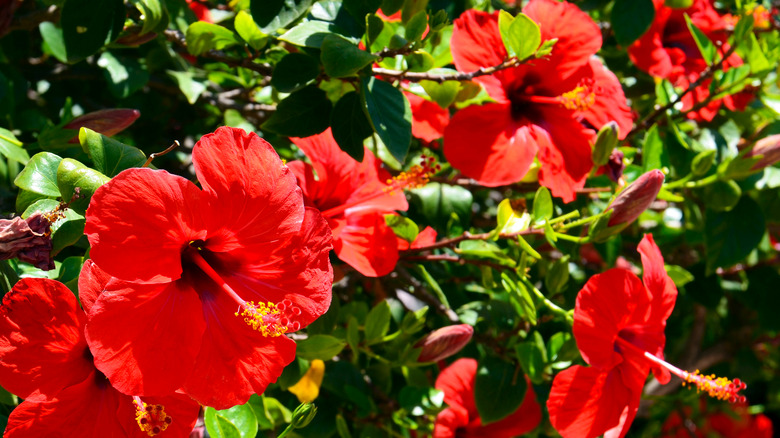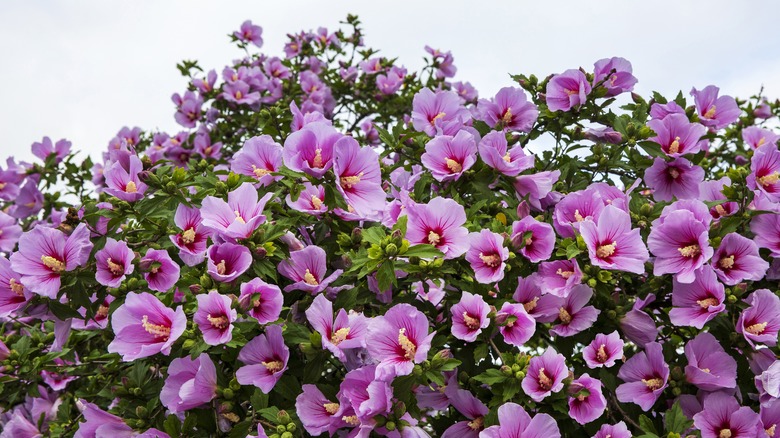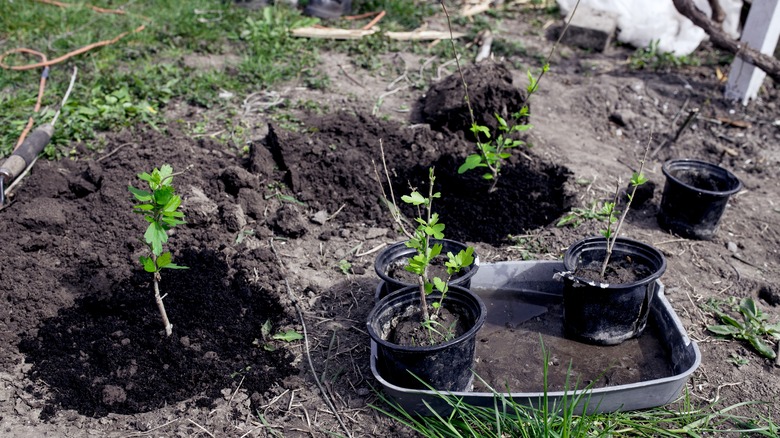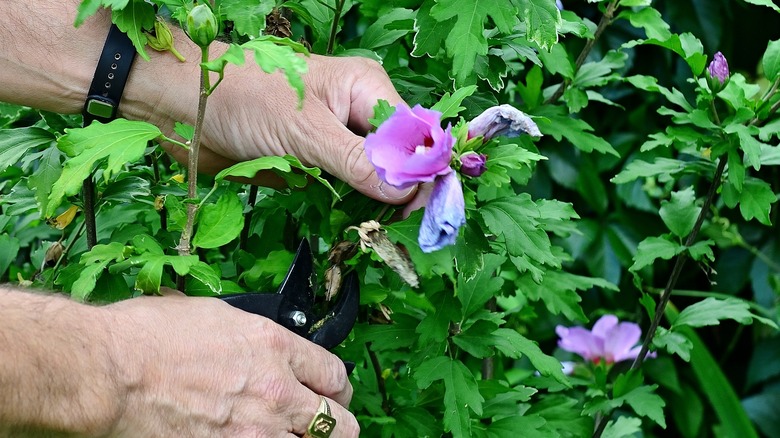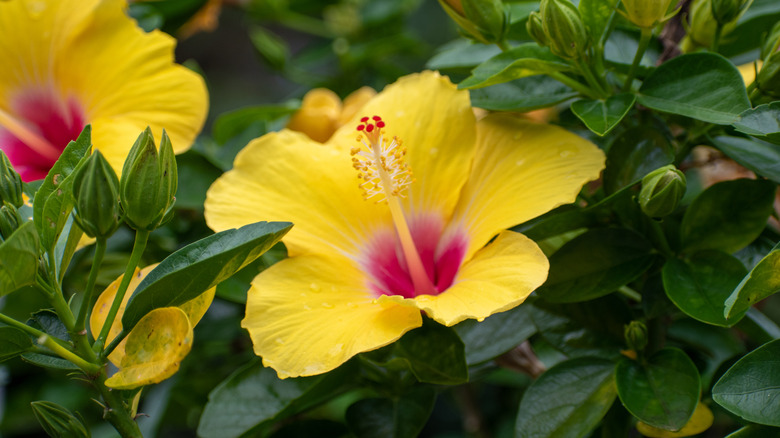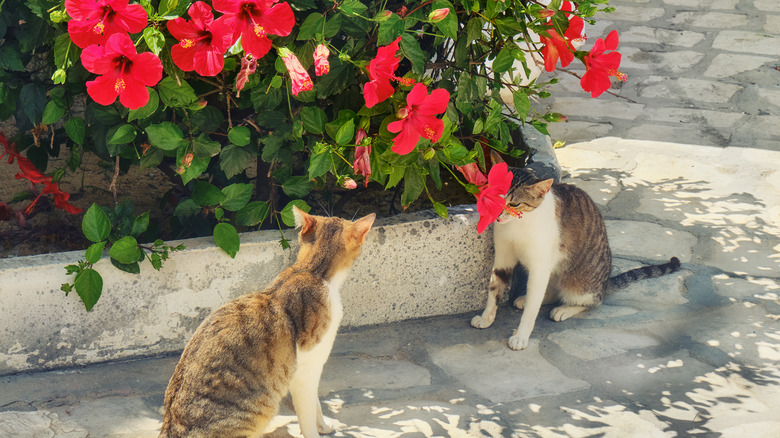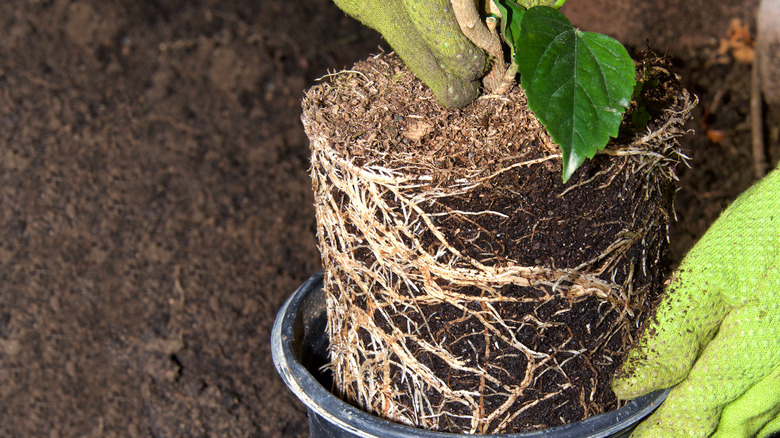Everything You Need To Know About Hibiscus Flowers Before Planting
Hibiscus flowers (Hibiscus spp.) are one of the easiest plants to grow to give your garden a burst of vibrant color. Their bright, five-colored petals surround a long floral tube, the large flowers standing out against the green oval-shaped leaves. Available in a variety of sizes, some species can grow up to 10 feet tall and 8 feet wide when fully mature, according to The Spruce. Hibiscus flowers are widely associated with the warm, tropical climates to which they are native, including Madagascar, Fiji, Mauritius, and Hawaii, where it represents the culture as the state flower (per Hidden Valley Hibiscus).
As far back as the early 1700s, species of Hibiscus flowers were spread around the globe by ships departing from Mauritius. Botanists from many foreign countries were fascinated by the flower and began documenting their studies of the plant. That fascination persisted, and before long botanists began developing hybrids and cultivars to further the most coveted traits, according to Hidden Valley Hibiscus. It seems the flower's popularity has never waned, and they are used in landscaping schemes in warm regions throughout the world today. The aptly named 'Brilliant' variety of hibiscus is perhaps the best-known example of the species, stunning with its large, vivid red blossoms.
How to use hibiscus flowers in garden
Hibiscus flowers come in so many different colors that any variety can add some fun to your home. Most hibiscus' grow as shrubs, but they can easily be pruned into a more refined, tree-like shape. Their bushy form makes them perfect for creating borders in your garden, whether you choose to plant just one color, or mix it up with a rainbow array of different hues. Taller species can even be used to line a fence or form a hedge for additional privacy in your yard, as Brecks suggests.
If you'd rather highlight the hibiscus' showy flowers, you can plant them in a more prominent area of your property, such as lining the entry to your front door. Hibiscus flowers will also attract helpful pollinators to your yard, such as bees, butterflies, and even hummingbirds. Planting hibiscus in containers gives you more options to use them as decor in or outside your home, and allows you to bring them in to overwinter if you live in a colder region. Place your potted hibiscus in any area with direct sunlight and let it naturally enhance your indoor space with its color and beauty.
How to grow hibiscus flowers
Growing hibiscus plants doesn't require a lot of hard work, especially if you set them up to succeed before their blooming season in the summer to early fall. To plant your hibiscus, you'll need a few supplies such as well-draining, slightly acidic soil, a trowel, mulch, and a designated, sunny area of your yard, according to Almanac. It's easier to select young hibiscus plants from a local garden center or nursery, but if you decide to plant from seed, you'll need to sow them 12 weeks before the region's frost date. They can also be sown outside before the last frost date, but it makes the growing process longer.
Choose a spot in your garden that received full to partial sun, and is protected from strong winds. Use a trowel to dig a hole in the ground slightly larger than your young, potted hibiscus. If you're planting multiple hibiscus plants, keep about 2 to 3 feet of space between them. Place the plant into its new home with the stem sticking out above the ground, and add well-draining soil to fill in any gaps. Pack the top of the soil with mulch to retain moisture and prevent root damage during cold weather. Water the plants regularly to keep their soil moist, especially at the beginning of their growing season. You can reduce watering in colder seasons.
How to care for hibiscus flowers
Hibiscus flowers only bloom for a couple of days, but if they're grown properly they'll continuously produce new flowers as their old ones fall off according to The Spruce. In order to prevent their flowers from dropping prematurely, keep them in warmer temperatures and out of the cold. They enjoy temperatures from 65 to 80 degrees Fahrenheit. Regular pruning will also keep your plants healthy and long-lasting. They should be pruned during the winter once they've reached their mature stage after they have ceased blooming. Trimming off deadened leaves and damaged branches will keep the hibiscus plants alive longer.
Feeding the plants fertilizer will also help them reach their full bloom potential, per The Spruce. Fertilizers containing nutrients such as potassium and nitrogen are great to have along with formulas containing organic matter such as fish emulsion and seaweed extract. You'll want to feed them with a half-strength solution before they first begin to bloom, and then switch over to fertilizing them every couple of weeks.
Hibiscus flower varieties
There are hundreds of different hibiscus species that are native to Asia and the Pacific Islands, according to The Tropical Hibiscus. Hibiscus flowers can grow as single flowers or large shrubs growing from 3 to 10 feet tall and 2 to 8 feet wide. Although there are different varieties, they fall under three separate categories: tropical, perennial, and hardy. Tropical hibiscus plants can't tolerate cold temperatures at all, whereas perennial hibiscus' hibernate over the winter to remerge the following spring. The most resilient, hardy hibiscus plants can last through the winter. Here are just a few varieties of the over 200 available, according to Balcony Garden Web:
-
Hibiscus syriacus 'Blue Bird': Producing flowers with the perfect shade of blue petals, the Blue Bird hibiscus flower grows 3 to 4 feet tall.
-
Hibiscus 'Giant Rose Mallow': These flowers produce a beautiful mix of pink and white hues that bloom from summer until the end of fall as it gets close to winter.
-
Hibiscus rosa-sinensis 'Hawaiian Hibiscus': This variety was named as Hawaii's state flower, and its showy yellow flowers with red centers bloom from spring to midsummer.
-
Hibiscus trionum 'Flower of an Hour': One of the better species to have in your garden if you want to stand out, this smaller variety showcases yellow to cream-colored flowers with purple accents.
-
Hibiscus sabdariffa 'Roselle': This edible variety is well-known and often used in herbal drinks, medicine, and culinary dishes.
Are hibiscus flowers toxic?
Though beautiful, the hibiscus plant can, unfortunately, cause some harm to your pets. The Humane Society of Charlotte reports that varieties such as "Rose of Sharon" (Hibiscus syriacus) are known to be harmful if ingested by your pets. Dogs may experience symptoms such as diarrhea, vomiting, and nausea if they consume the flower, and cats can be poisoned by both the stems and flowers of the plant. It is not known why some species of hibiscus are toxic to pets and others are not, but nevertheless, it is better to be safe rather than sorry and protect your pets from all hibiscus species.
Ingesting a small amount of hibiscus should not cause more than mild discomfort, but if your pet eats a large amount and exhibits worrying symptoms, you should seek medical care, and try to keep them hydrated. You can call the Animal Poison Control hotline or your local vet to find out if treatment is necessary. To prevent your pets from getting sick or poisoned, plant your hibiscus' in areas inaccessible to them.
How to repot hibiscus flowers
If you are growing your hibiscus in a container, you will likely need to repot the plant at some point. Hibiscus' can live in happily in containers for a long time, but once their roots begin to grow through the draining holes or look tightly packed in their container, then it's time to move up to a larger pot, according to Sunday Gardener. Repotting is easy, but you'll need a larger container, well-draining potting soil, pruning shears, and mulch.
Prepare a new container with 2 inches of well-draining soil and water it enough to where it's moist. Remove the hibiscus from the old container by gently pulling your hibiscus out and slowly shaking the plant to get rid of the old soil. Once you've removed most of the old soil, detangle and loosen the roots by pulling them gently away from each other. If the roots are too tangled, you can cut strategically the tips with pruning shears to set them free. After they're untangled, prune about ⅓ of the roots so that they can continue growing. Place the plant into the new container, making sure that the root ball is about 2 to 4 inches below the rim of the container. Fill the remaining space in the container with potting soil and water it until it's moist. Add mulch to the top to lock in the moisture and further protect the plant.

